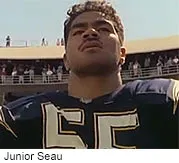Study adds to understanding of chronic traumatic encephalopathy
WebMD News from HealthDay

By Maureen Salamon
HealthDay Reporter
WEDNESDAY, Aug. 21 (HealthDay News) -- A devastating brain disease associated with the head trauma incurred by football players, boxers and other athletes typically affects patients in one of two major ways, a new study suggests.
Boston University researchers found that the neurodegenerative disease chronic traumatic encephalopathy (CTE) initially impairs either behavior and mood, or memory and thinking abilities. The disorder, characterized by impulsivity, depression and erratic behavior, is only diagnosed after death.
"The study itself is relatively preliminary, [but] we found two relatively distinct presentations of the disease," said study co-author Daniel Daneshvar, a postdoctoral researcher at the university's Center for the Study of Traumatic Encephalopathy. "So little is known about the clinical presentation of CTE that anything we found is not necessarily surprising, simply because there's a dearth of information about CTE."
CTE has come to the forefront in recent years with a class-action lawsuit filed last year by nearly 4,000 former NFL football players who claim the league failed to protect players from traumatic brain injuries or warn them about the dangers of concussions. Also, the U.S. National Institutes of Health determined in January that former NFL star linebacker Junior Seau had CTE when he killed himself last year.
The condition is also documented in military personnel exposed to explosive blasts.
For the current study, published online Aug. 21 in the journal Neurology, researchers examined the brains of 36 male athletes aged 17 to 98 who had been diagnosed with CTE after death. The research is said to be the largest of its kind on the disorder, first described by scientists in 1928 and called "punch drunk syndrome."
Daneshvar and his colleagues interviewed participants' family members, finding that 22 of the athletes suffered behavior or mood problems as their first symptoms of CTE, while 11 first had memory and thinking problems. Three participants showed no CTE symptoms at the time of death. Most of the athletes played amateur or professional football, with the rest participating in hockey, wrestling or boxing.
Those with behavior and mood problems experienced symptoms at a younger age, with the first signs appearing at an average age of 35, compared to age 59 for those with memory and thinking problems. Those experiencing mood symptoms were reported to be more explosive, depressed, out of control and physically and verbally violent than the group enduring memory and thinking deficits.
Daneshvar cautioned that the findings were limited since no comparison group of former athletes without CTE was part of the research. Also, families who were interviewed may have witnessed more severe symptoms, making them more likely to participate in the study, he said.
Neuropsychologist Ken Podell, co-director of the Houston Methodist Concussion Center, said the research "is clearly a first attempt, and they present it as such."
"This whole concept of the clinical presentation of CTE is very much in its infancy, and we don't really know what it is," Podell said. "Understanding the limitations of this study are very critical, making sure that someone doesn't take this information and generalize it to the general population or someone with a single head injury."
Scientists have not yet determined if CTE is linked to the number of concussions an individual suffers, whether from sports or other causes. Another contributor may be an accumulation of subconcussive blows an athlete suffers that don't result in clinical signs of concussion.
Preliminary research such as this doesn't offer guidance for athletes or concrete ways to spot CTE earlier, Podell and Daneshvar agreed. But Podell offered one strategy: "Stay away from getting your head hit."
source : Brain-Damaged Athletes May Show Mood or Thinking Impairments First








